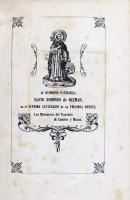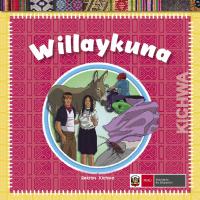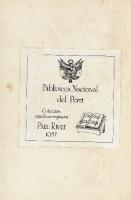Quichua/ Quechua names of sweet potatoes
145 57 5MB
English Pages [21] Year 1916
Front Cover
Title Page
Section 1 (Page 86)
Recommend Papers

- Author / Uploaded
- Orator Fuller Cook
File loading please wait...
Citation preview
Quichua names of sweet potatoes ... Cook, O. F. (Orator Fuller), 1867-1949. [Washington, D.C., 1916] https://hdl.handle.net/2027/yale.39002005801122
Public Domain http://www.hathitrust.org/access_use#pd We have determined this work to be in the public domain, meaning that it is not subject to copyright. Users are free to copy, use, and redistribute the work in part or in whole. It is possible that current copyright holders, heirs or the estate of the authors of individual portions of the work, such as illustrations or photographs, assert copyrights over these portions. Depending on the nature of subsequent use that is made, additional rights may need to be obtained independently of anything we can address.
Yale Peruvian expeditions, 1911-1915,
Publications, v. 51.
YALE UNIVERSITY LIBRARY
1922
Quichua Names of Sweet Potatoes O. F. COOK
Reprinte'd from the Jouhnal of the Washington Academy of Sciences, Vol. VI, No. 4, February 10, 1916
Reprinted from the
Journal
Of the Washington Academy of Sciences Vol. VI, No. 4, February 19, 1916
ETHNOBOTANY. — Quichua
names
Cook, Bureau of Plant Industry.
of sweet potatoes.
0. F.
Quichua was the language of the Incas at the time of the Span ish conquest of Peru, and is still spoken by a large native popula tion. The ancient center of the Quichuas is in the region about Cuzco on the eastern slope of the Andes, from an altitude of
cook: quichua names of sweet potatoes
87
over 14,000 feet at the Pass of La Raya, down to Santa Ana, at an altitude of 3000 feet. The lower valley of the Urubamba river was visited by the writer in May, June, and July, 1915, as a member of the Yale Peruvian Expedition conducted by Prof. Hiram Bingham, of Yale University, in cooperation with the National Geographic Society and the United States Depart ment of Agriculture. At 6000 feet and below, the sweet potato (Ipomoea batatas) is one of the principal root-crops. At Santa Ana it appears important to be somewhat less than rumu (Manihot) or uncucha (Xanthosoma), but much more important than achira (Canna). Two classes of sweet potatoes are recognized under separate names, apichu for the sweet varieties and cumara for the starchy.
A similar distinction is often made in the United States between "sweets"
"yams."
and The Quichua language seems to have no inclusive term that can be applied to all kinds of sweet potatoes. For this purpose Spanish-speaking Quichuas use the word "camote."
Both cumaras and apichus are represented by numerous varieties differing in shape and color of roots and foliage. At San Miguel, in the valley under Machu Picchu, with an alti
tude of 6000 feet, three varieties of cumaras were noted : yuracjcumara (white), pucacumara (red), and compillicjlla, the last a very short turnip-shaped- purple root. Of apichus there were also three varieties, yuracjapichu, pucaapichu, and azulapichu Other names, (blue, a combination of Spanish and Quichua). learned at Santa Ana, are oqquechuto, cusicumara, and pucacusi"red-long-cumara." cumara, the last mentioned said to mean Another with deep purple flesh like a beet, that stains the tongue, At Lima the Quichua names is called incampamaccasccan. Two varieties grown are not recognized, only camote being used. supano called and luriniano, between Lima and Callao are the former with leaves very deeply cut, the latter with nearly Supe and Lurin are places on the coast not far entire leaves. from Lima. Wild sweet potatoes are said to be of common occurrence in At San Miguel a plant identified the valleys of the interior. cusiapichu was fo«St^growing spontaneously by the Indians as
Saw*
f3"*
4
r^
s\
88
cook: quichua names
of sweet potatoes
At Santa Ana three distinct judge from the foliage, were found as common weeds in kinds, to cultivated land. Bnt to certify that any plant is a genuine native species seems out of the question in a region where all of the land has probably been cleared many times and cultivated inter mittently for centuries. On the other hand, there is no reason to deny that the sweet potato may have been domesticated in the Peruvian region, as many other plants appear to have been. The words apichu and cumara have been recorded before, but without indications of their concurrent use and distinct applications among the Quichuas. Markham's Quichua Vo gives apichu as the name of the sweet potato, but over cabulary looks cumara altogether. Reference might also be made to Holguin's Arte y Diccionario without finding cumara, since the word does not appear in its alphabetic position, but under apichu Camote/' Martius's Ethnowe find: "Apichu, cumar, nom. graphie has neither apichu nor cumara, but gives camote as the Quichua name, with a derivation from the Mexican camotli. Cobo, whose Historia was written in Peru less than seventy years after the conquest (though not published till 1890), recorded apichu as the Quichua name, tutuca as the Aymara name, and camote as the name used by the Spaniards of Peru, borrowed from the language of Mexico. Cobo appears to have visited the in terior of Bolivia, but not the interior of Peru. No reason is apparent for questioning the status of apichu and cumara as genuine Quichua words. Etymologies would be easy to invent. For apichu such a combination as api (maize pichu pudding) and (flesh) or pichi (root) would be appropriate, while cumara might he related to ccumu or kumu, meaning
in a place not recently cultivated.
crooked or hunch-backed. Other Quichua names analogous to pallar cumar or cumara are (Phasaeolus), quinuar (Buddleia), quisuar (Polylepis), ancara (gourd), sara (Zea), tara (Caesalpinia tinctoria), and achira (Canna). The sweet potato was not known to Europeans before the discovery of America. The first name that the Spaniards learned and carried back to Spain was batata, the original of our word potato., but the Mexican name camote is now more widely
cook: quichua names oy sweet potatoes
89
known in Spanish America. Many names in local languages have probably been lost, but some have been placed on record. Martins collected the following series from native tribes of Brazil: coutarouti, coundi, gnunana, hetich, ictig, imazaka, jetica, joto, mapas (?), maporu, mapuey, mouka, napi, orairai, quaiu, tsa, and zamaygua. In the Kekchi language of eastern Guatemala, a member of the Maya family, the sweet potato bears the name is. The Kekchis do not raise many sweet potatoes, this crop being dis tinctly less important than osh (Xanthosoma) or piyak (Dios corea), yet sweet potatoes often grow as weeds in cultivated lands. The potato (Solanum tuberosum) is called by the Kekchis kashpotato." lanis, meaning "foreign sweet Several of the early Spanish historians of the West Indies recorded the name age or aje, but whether this belonged properly to the sweet potato or to some other root-crop has been uncer Some of the accounts evidently refer to Manihot, but Gray and Trumbull settled upon Dioscorea as the correct appli cation.1 Gomez de la Maza claims both age and boniato as in digenous Cuban names of sweet potatoes. More than a score of Cuban varieties are listed, mostly with names derived from Boniato is the name in regular native languages of the Island. Batata is used in use in Cuba, batata being scarcely known.2 indigenous and but two names, Venezuela, Panama; Rico, Puerto reported primitive tribes by Pittier from araba and deki, are living on the Atlantic slope of Costa Rica.3 Among all these, names of sweet potatoes in other parts of
tain.
America there appears to be no definite resemblance to either Perhaps the nearest of the Quichua words, apichu and cumara. approach to similarity is between cumara and the Mexican Yet the number and diversity of the native camote or camotli. names are not without significance as indications of the American 1 Gray A., and Trumbull, J. H. Review of de Candolle's Origin of Cultivated Plants; with annotations upon certain American species. American Journal of Science, Third Series, 25: 250. 1883. 2 Gomez de la Maza, M. Diceionario Botanico de los Nombres Vulgares 1889. Cubanos y Puerto-Riquefios. 8 Pittier, H. Plantas Usuales de Costa Rica, 165. 1908.
cook: quichua names op sweet potatoes
90
origin of the sweet potato or, at least, of its wide distribution in prehistoric times. The general interest of the Quichua names lies in the fact that cumara or kumara is also the name of the sweet potato in the Polynesian Islands. This was first pointed out by Seemann, a botanist who had visited the Pacific Islands and the west coast of South America about fifty years ago. Seemann's ob servation appeared as a brief editorial note in connection with a statement by the ethnologist Crawfurd, to the effect that no communication could have taken place between the American continent and the Pacific Islands.4
The presence of the Quichua name in Ecuador is readily under stood, the native kingdom of Quito having been conquered and occupied by the Incas. Some of the early Spanish historians of Peru recorded Inca traditions of voyages to islands in the Pacific, but such a possibility of communication between the American continent and the Pacific Islands has not seemed worthy of serious consideration. Nevertheless, cultivated plants of American origin appear to have crossed the Pacific before the arrival of Europeans. Among these trans-Pacific plants are the coconut palm, the bottle-gourd, and the sweet potato. Coconuts and gourds may be supposed to have floated to the Islands and es tablished themselves without human assistance, but the sweet potato and its name could hardly be conveyed in this manner. Nor is it to be taken as a mere coincidence that a Quichua name not shared with other American languages should be associated with the same crop in the Pacific Islands. 4 Crawfurd,
John. On the migrations of cultivated plants in reference to Seemann's Journal of Botany, 4: 328. 1866. "The Sweet Potato, or tuber-yielding Convolvulus, appears to be a native of many parts of the tropical Old and New World. Some have alleged that it was first made an object of cultivation by the native Americans, but when the South Sea Islands, which had assuredly no communication with the American people, were discovered, the sweet potato was found to be in cultivation, and known by a native name throughout, the word being essentially the same, and a native one varying only in pronunciation, as kumava, humaa, and gumdla abbreviated mala." ethnology.
Seemann's comment on the above statement was as follows: "[Kumara or umara, of the South-Sea Islanders, is identical with cumar, the Quichua name for sweet potato in the highlands of Ecuador. — Ed.]
3 9002 00580 1122








